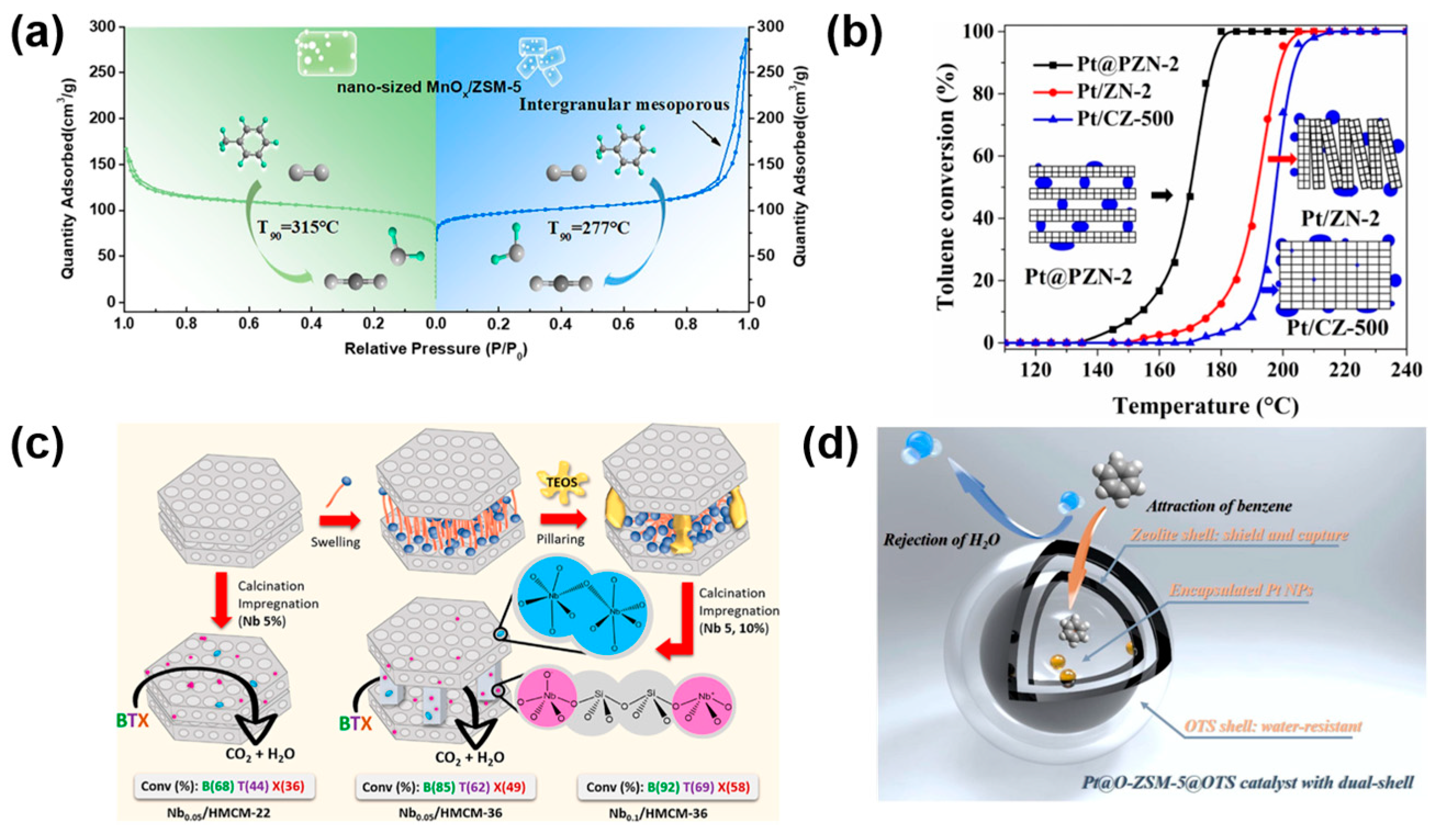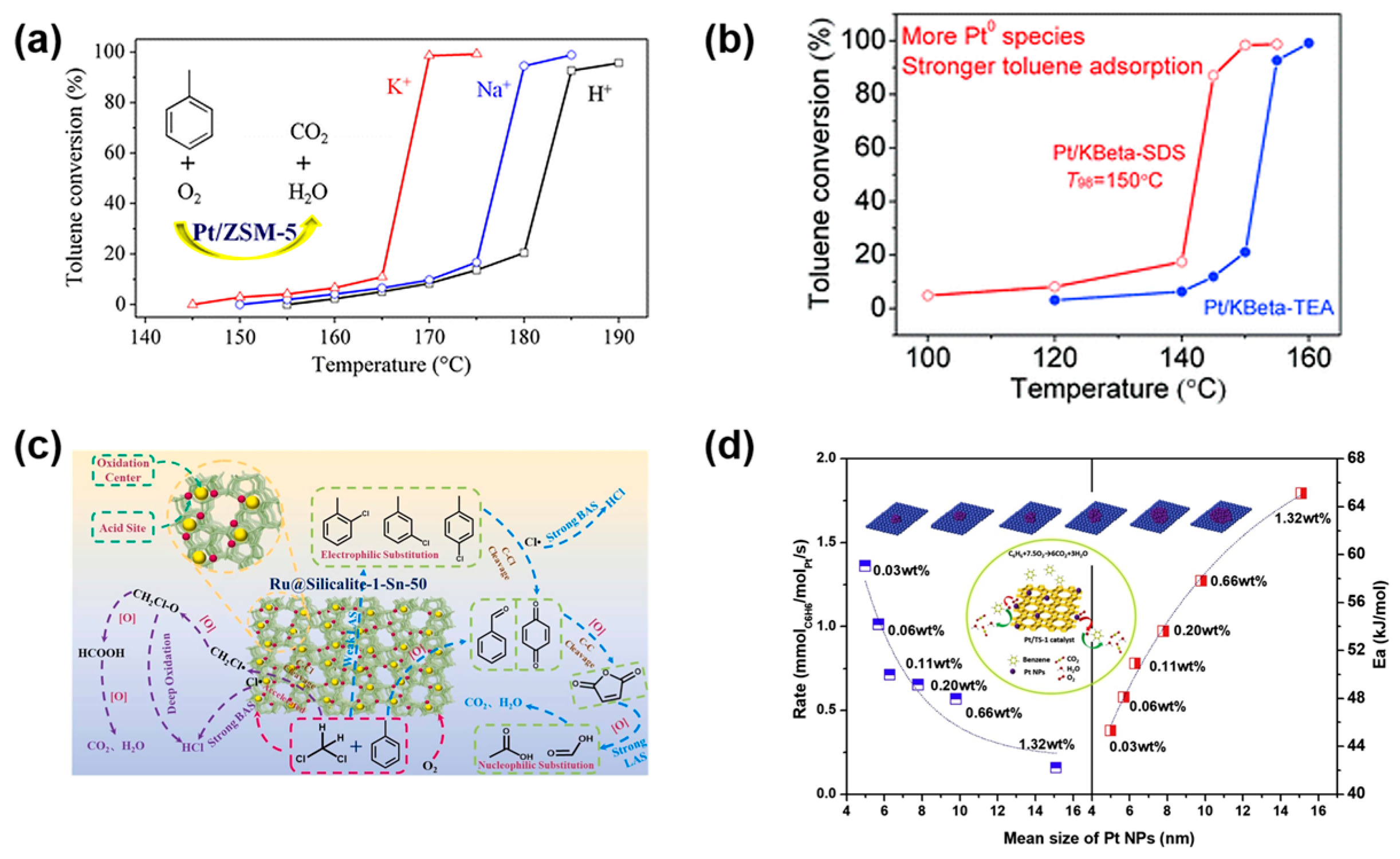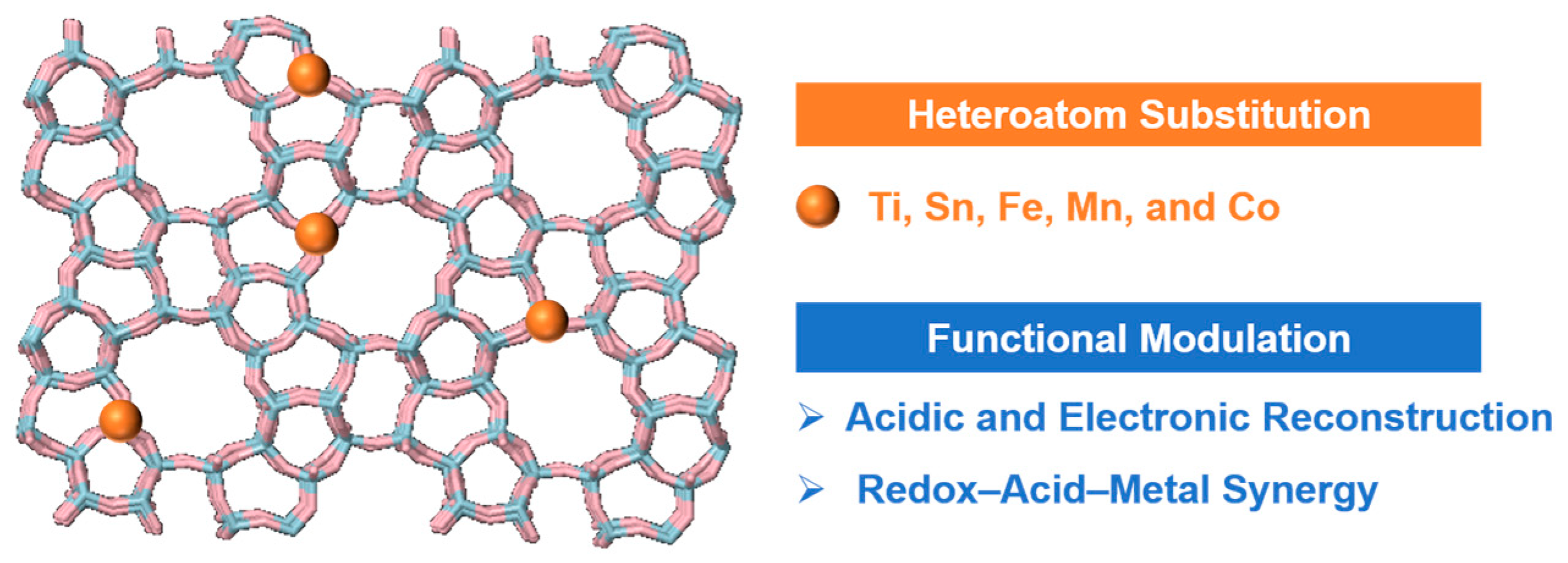Microenvironment Regulation in Zeolite-Based Catalysts for Selective Oxidation of Aromatic VOCs
Abstract
1. Introduction
2. Zeolite Pore Architecture
2.1. Influence of Zeolite Topology on Catalytic Oxidation of Aromatic VOCs
2.2. Hierarchical Porosity for Enhanced Diffusion and Metal Dispersion

2.3. Confinement Effects of Zeolitic Voids on Metal Site Functionality
3. Zeolitic Acidity Engineering
3.1. Acid Site Characteristics of Zeolite Support
3.2. Cation Regulation of Acidity and Metal–Support Interactions
4. Framework Composition Engineering: Heteroatom Substitution for Functional Modulation
5. Surface and Interface Engineering Strategies
5.1. Nanostructuring and Morphological Control

5.2. Hydrophobic Surface Modification
5.3. Structural Interface Architecture Engineering
6. Challenges and Future Perspectives
6.1. Challenges in Microenvironment-Oriented Catalyst Design
6.2. Future Perspectives: Toward Integrated Microenvironment–Metal Architectures
7. Conclusions
Author Contributions
Funding
Data Availability Statement
Conflicts of Interest
References
- Atkinson, R.; Arey, J. Atmospheric Degradation of Volatile Organic Compounds. Chem. Rev. 2003, 103, 4605–4638. [Google Scholar] [CrossRef] [PubMed]
- Verdoliva, V.; Saviano, M.; De Luca, S. Zeolites as Acid/Basic Solid Catalysts: Recent Synthetic Developments. Catalysts 2019, 9, 248. [Google Scholar] [CrossRef]
- Chen, X.; Yang, G.; Valtchev, V. Environmentally benign synthesis of crystalline nanosized molecular sieves. Green Energy Environ. 2020, 5, 394–404. [Google Scholar] [CrossRef]
- Yang, G.; Yu, J. Advancements in Basic Zeolites for Biodiesel Production via Transesterification. Chemistry 2023, 5, 438–451. [Google Scholar] [CrossRef]
- Chen, X.; Huang, J.; Yang, G. Advances and Challenges in Zeolite-Based Catalysts for the Selective Catalytic Oxidation of Ammonia. Catalysts 2025, 15, 204. [Google Scholar] [CrossRef]
- Zhang, J.; Xu, X.; Zhao, S.; Meng, X.; Xiao, F.-S. Recent advances of zeolites in catalytic oxidations of volatile organic compounds. Catal. Today 2023, 410, 56–67. [Google Scholar] [CrossRef]
- He, J.; Chen, D.; Li, N.; Xu, Q.; Li, H.; He, J.; Lu, J. Controlled fabrication of mesoporous ZSM-5 zeolite-supported PdCu alloy nanoparticles for complete oxidation of toluene. Appl. Catal. B 2020, 265, 118560. [Google Scholar] [CrossRef]
- Peng, S.; Yang, G.; Zhang, J. ZSM-5 nanocrystal promoted low-temperature activity of supported manganese oxides for catalytic oxidation of toluene. Inorg. Chem. Commun. 2022, 143, 109759. [Google Scholar] [CrossRef]
- Zhang, L.; Peng, Y.; Zhang, J.; Chen, L.; Meng, X.; Xiao, F.-S. Adsorptive and catalytic properties in the removal of volatile organic compounds over zeolite-based materials. Chin. J. Catal. 2016, 37, 800–809. [Google Scholar] [CrossRef]
- Chen, C.; Chen, F.; Zhang, L.; Pan, S.; Bian, C.; Zheng, X.; Meng, X.; Xiao, F.-S. Importance of platinum particle size for complete oxidation of toluene over Pt/ZSM-5 catalysts. Chem. Commun. 2015, 51, 5936–5938. [Google Scholar] [CrossRef]
- Lan, W.; Shen, M.; Chen, Y.; Niu, K.; Zhou, W.; Xu, J.; Huang, B.; Cai, H.; Zuo, J.; Lin, D.; et al. Pt anchored in the skeleton of rice husk-based ZSM-5 for excellent catalytic VOC oxidation: Structure–activity relationship and environmental impact assessment. Green Chem. 2024, 26, 4051–4064. [Google Scholar] [CrossRef]
- Li, Z.; Gao, R.; Hou, Z.; Yu, X.; Dai, H.; Deng, J.; Liu, Y. Tandem supported Pt and ZSM-5 catalyst with separated catalytic functions for promoting multicomponent VOCs oxidation. Appl. Catal. B 2023, 339, 123131. [Google Scholar] [CrossRef]
- Li, D.; Wang, L.; Lu, Y.; Deng, H.; Zhang, Z.; Wang, Y.; Ma, Y.; Pan, T.; Zhao, Q.; Shan, Y.; et al. New insights into the catalytic mechanism of VOCs abatement over Pt/Beta with active sites regulated by zeolite acidity. Appl. Catal. B 2023, 334, 122811. [Google Scholar] [CrossRef]
- Kim, M.-R.; Kim, S. Enhanced Catalytic Oxidation of Toluene over Hierarchical Pt/Y Zeolite. Catalysts 2022, 12, 622. [Google Scholar] [CrossRef]
- Yang, D.; Fu, S.; Huang, S.; Deng, W.; Wang, Y.; Guo, L.; Ishihara, T. The preparation of hierarchical Pt/ZSM-5 catalysts and their performance for toluene catalytic combustion. Microporous Mesoporous Mater. 2020, 296, 109802. [Google Scholar] [CrossRef]
- Wang, J.; Guo, X.; Shi, Y.; Zhou, R. Synergistic effect of Pt nanoparticles and micro-mesoporous ZSM-5 in VOCs low-temperature removal. J. Environ. Sci. 2021, 107, 87–97. [Google Scholar] [CrossRef]
- Wang, Y.; Yang, D.; Li, S.; Chen, M.; Guo, L.; Zhou, J. Ru/hierarchical HZSM-5 zeolite as efficient bi-functional adsorbent/catalyst for bulky aromatic VOCs elimination. Microporous Mesoporous Mater. 2018, 258, 17–25. [Google Scholar] [CrossRef]
- Chen, C.; Zhu, J.; Chen, F.; Meng, X.; Zheng, X.; Gao, X.; Xiao, F.-S. Enhanced performance in catalytic combustion of toluene over mesoporous Beta zeolite-supported platinum catalyst. Appl. Catal. B 2013, 140–141, 199–205. [Google Scholar] [CrossRef]
- Zhang, J.; Rao, C.; Peng, H.; Peng, C.; Zhang, L.; Xu, X.; Liu, W.; Wang, Z.; Zhang, N.; Wang, X. Enhanced toluene combustion performance over Pt loaded hierarchical porous MOR zeolite. Chem. Eng. J. 2018, 334, 10–18. [Google Scholar] [CrossRef]
- Tian, J.; Tan, K.B.; Liao, Y.; Sun, D.; Li, Q. Hollow ZSM-5 zeolite encapsulating Pt nanoparticles: Cage-confinement effects for the enhanced catalytic oxidation of benzene. Chemosphere 2022, 292, 133446. [Google Scholar] [CrossRef]
- He, T.; Li, G.; Ji, J.; Liu, W.; Zhang, H.; Xie, X.; Huang, S.; Huang, T.; Peng, H. Tailored engineering of intracrystalline mesopores for boosting multicomponent volatile organic compounds simultaneous deep oxidation. Appl. Catal. B-Environ. Energy 2025, 362, 124752. [Google Scholar] [CrossRef]
- Ding, S.; Wu, S.; Fang, N.; Chu, Y.; Wang, P.; Ding, L. Design and synthesis of porous nano-confined catalysts for VOCs oxidation: A critical review based on pollutant sorts. Sep. Purif. Technol. 2025, 352, 128158. [Google Scholar] [CrossRef]
- Tian, J.; Wang, C.; Wu, J.; Sun, D.; Li, Q. Enhancing water resistance of Pt nanoparticles by tailoring microenvironment of hollow ZSM-5 for efficient benzene oxidation. Chem. Eng. J. 2023, 451, 138351. [Google Scholar] [CrossRef]
- Tang, S.; Liu, H.; Li, T.; Wang, C.; Cui, Q.; Yue, Y.; Meng, X.; Bao, X. Encapsulating platinum nanoparticles into multi-hollow silicalite-1 zeolite for catalytic oxidation of volatile organic compounds. Chem. Eng. Sci. 2024, 286, 119674. [Google Scholar] [CrossRef]
- Li, C.; He, T.; Yan, J.; Li, G.; Liu, W.; Zhang, H.; Chen, J.; Lu, J.; Zhang, S.; Peng, H. An effective strategy for promoting toluene oxidation stability: Recrystallization Pt confinement and zeolite dealumination. Fuel 2024, 372, 132268. [Google Scholar] [CrossRef]
- Wang, L.; Dong, F.; Han, W.; Tang, Z. Engineering a Mesoporous Pt/Ce-ZSM-5 Catalyst by a Confined Encapsulation Strategy for Low-Temperature Catalytic Combustion of Toluene. Ind. Eng. Chem. Res. 2024, 63, 22354–22368. [Google Scholar] [CrossRef]
- Corma, A. From microporous to mesoporous molecular sieve materials and their use in catalysis. Chem. Rev. 1997, 97, 2373–2420. [Google Scholar] [CrossRef]
- Zhang, J.; Li, F.; Meng, X.; Xiao, F.-S. Challenges and opportunities for zeolite-based catalysts in catalytic oxidation of volatile organic compounds. Catal. Sci. Technol. 2024, 14, 3277–3286. [Google Scholar] [CrossRef]
- Zhang, C.; Huang, H.; Li, G.; Wang, L.; Song, L.; Li, X. Zeolitic acidity as a promoter for the catalytic oxidation of toluene over MnOx/HZSM-5 catalysts. Catal. Today 2019, 327, 374–381. [Google Scholar] [CrossRef]
- Xie, K.; Jiang, B.; Wang, Z.; Zuo, S.; Wang, Q. Study on the performance and sulfur tolerance mechanism of Pd/beta zeolite in catalytic combustion of toluene. J. Mater. Res. Technol. 2023, 25, 4543–4553. [Google Scholar] [CrossRef]
- Wang, J.; Hou, C.; Wang, X.; Xing, Y.; Xie, Y.; Wang, L.; Zhang, M. Low-content Pt loading on a post-treatment-free zeolite for efficient catalytic combustion of toluene. Microporous Mesoporous Mater. 2024, 363, 112832. [Google Scholar] [CrossRef]
- Wang, Z.; Jin, Z.; Ning, H.; Jiang, B.; Xie, K.; Zuo, S.; Wang, Q. Study on sulfur resistance of MnO2/Beta zeolite in toluene catalytic combustion: The effect of increased acidity on catalytic performance. Chin. J. Chem. Eng. 2025, 78, 187–195. [Google Scholar] [CrossRef]
- Tidahy, H.L.; Siffert, S.; Lamonier, J.F.; Cousin, R.; Zhilinskaya, E.A.; Aboukaïs, A.; Su, B.L.; Canet, X.; De Weireld, G.; Frère, M.; et al. Influence of the exchanged cation in Pd/BEA and Pd/FAU zeolites for catalytic oxidation of VOCs. Appl. Catal. B 2007, 70, 377–383. [Google Scholar] [CrossRef]
- Chen, C.; Wu, Q.; Chen, F.; Zhang, L.; Pan, S.; Bian, C.; Zheng, X.; Meng, X.; Xiao, F.-S. Aluminium-rich Beta zeolite-supported platinum nanoparticles for the low-temperature catalytic removal of toluene. J. Mater. Chem. A 2015, 3, 5556–5562. [Google Scholar] [CrossRef]
- Chen, C.; Wang, X.; Zhang, J.; Pan, S.; Bian, C.; Wang, L.; Chen, F.; Meng, X.; Zheng, X.; Gao, X.; et al. Superior Performance in Catalytic Combustion of Toluene over KZSM-5 Zeolite Supported Platinum Catalyst. Catal. Lett. 2014, 144, 1851–1859. [Google Scholar] [CrossRef]
- Wu, L.; Deng, J.; Liu, Y.; Jing, L.; Yu, X.; Tao, J.; Gao, R.; Feng, Y.; Dai, H. Enhanced removal efficiency of multicomponent VOCs over the Sn-doped Silicalite-1-supported Ru single-atom catalysts by constructing tightly coupled redox and acidic sites. Appl. Catal. B-Environ. Energy 2024, 351, 123910. [Google Scholar] [CrossRef]
- Wu, B.; Chen, B.; Zhu, X.; Yu, L.; Shi, C. Lower loading of Pt on hydrophobic TS-1 zeolite: A high-efficiency catalyst for benzene oxidation at low temperature. Catal. Today 2020, 355, 512–517. [Google Scholar] [CrossRef]
- Rokicińska, A.; Drozdek, M.; Dudek, B.; Gil, B.; Michorczyk, P.; Brouri, D.; Dzwigaj, S.; Kuśtrowski, P. Cobalt-containing BEA zeolite for catalytic combustion of toluene. Appl. Catal. B 2017, 212, 59–67. [Google Scholar] [CrossRef]
- Peng, Y.; Zhang, L.; Jiang, Y.; Han, S.; Zhu, Q.; Meng, X.; Xiao, F.-S. Fe-ZSM-5 supported palladium nanoparticles as an efficient catalyst for toluene abatement. Catal. Today 2019, 332, 195–200. [Google Scholar] [CrossRef]
- Meng, Y.; Genuino, H.C.; Kuo, C.-H.; Huang, H.; Chen, S.-Y.; Zhang, L.; Rossi, A.; Suib, S.L. One-Step Hydrothermal Synthesis of Manganese-Containing MFI-Type Zeolite, Mn–ZSM-5, Characterization, and Catalytic Oxidation of Hydrocarbons. J. Am. Chem. Soc. 2013, 135, 8594–8605. [Google Scholar] [CrossRef]
- Liu, G.; Tian, Y.; Zhang, B.; Wang, L.; Zhang, X. Catalytic combustion of VOC on sandwich-structured Pt@ZSM-5 nanosheets prepared by controllable intercalation. J. Hazard. Mater. 2019, 367, 568–576. [Google Scholar] [CrossRef] [PubMed]
- Schwanke, A.J.; Balzer, R.; Wittee Lopes, C.; Motta Meira, D.; Díaz, U.; Corma, A.; Pergher, S. A Lamellar MWW Zeolite With Silicon and Niobium Oxide Pillars: A Catalyst for the Oxidation of Volatile Organic Compounds. Chem. Eur. J. 2020, 26, 10459–10470. [Google Scholar] [CrossRef]
- Schwanke, A.J.; Balzer, R.; Lopes, C.W.; Meira, D.M.; Díaz, U.; Pergher, S.; Bernardo-Gusmão, K. Structure and reactive properties of Nb-impregnated two-dimensional pillared MWW zeolites for total oxidation of volatile organic compounds. Microporous Mesoporous Mater. 2021, 327, 111425. [Google Scholar] [CrossRef]
- Zhao, S.; Fan, K.; Li, J.; Ma, Y.; Yang, F.; Meng, X.; Xiao, F.-S. Hydrophobic modification of zeolite-supported platinum catalysts for complete oxidation of toluene. Catal. Today 2024, 432, 114601. [Google Scholar] [CrossRef]
- Zhu, X.; He, X.; Guo, L.; Shi, Y.; Zhao, N.; Qiao, C.; Dai, L.; Tian, Y. Hydrophobic Modification of ZSM-5-Encapsulated Uniform Pt Nanoparticles for Catalytic Oxidation of Volatile Organic Compounds. ACS Appl. Nano Mater. 2022, 5, 3374–3385. [Google Scholar] [CrossRef]
- Meng, X.; Meng, L.; Gong, Y.; Li, Z.; Mo, G.; Zhang, J. Modifying Y zeolite with chloropropyl for improving Cu load on Y zeolite as a super Cu/Y catalyst for toluene oxidation. RSC Adv. 2021, 11, 37528–37539. [Google Scholar] [CrossRef] [PubMed]
- Liu, X.; Liu, D.; Wang, Y.; Chen, B.; Shi, C. Construction of sandwich type RuOn supported on Ag@hollow-zeolite catalysts for toluene enrichment and oxidation with superior chlorine resistance. Sep. Purif. Technol. 2025, 361, 131426. [Google Scholar] [CrossRef]
- Zhang, C.; Wang, C.; Huang, H.; Zeng, K.; Wang, Z.; Jia, H.-P.; Li, X. Insights into the size and structural effects of zeolitic supports on gaseous toluene oxidation over MnOx/HZSM-5 catalysts. Appl. Surf. Sci. 2019, 486, 108–120. [Google Scholar] [CrossRef]



| Zeolite Parameter | Aromatic VOC | Catalyst | Feed Conditions | Catalytic Performance | Reference |
|---|---|---|---|---|---|
| Topology | Toluene | Pt/ZSM-5-T2 | 60,000 mL/gh, 1000 ppm, 21% O2, N2 | T90 at 170 °C | [11] |
| Toluene | PtSn/CeO2&Mn/ZSM-5 | 40,000 mL/gh, 1000 ppm, 20% O2, N2 | T90 at 296 °C | [12] | |
| Toluene | Pt/Beta-260 | 20,000 mL/gh, 200 ppm, 20% O2, N2 | T90 at 160 °C | [13] | |
| Toluene | Pt/Y | 60,000 mL/gh, 1000 ppm, 21% O2, N2 | T90 at 149 °C | [14] | |
| Hierarchical Porosity | Toluene | Pt/mZSM-5 | 80,000 mL/gh, 500 ppm, 20% O2, N2 | T90 at 159 °C | [15] |
| Toluene | Pt/ZSM-5 | 22,500 mL/gh, 1000 ppm, 20% O2, N2 | T90 at 128 °C | [16] | |
| Toluene | Ru/m-HZSM-5 | 80,000 mL/gh, 500 ppm, 10 vol% O2, 1.58 wt% H2O/N2 | T90 at 243 °C | [17] | |
| o-Xylene | Ru/m-HZSM-5 | 80,000 mL/gh, 300 ppm, 10 vol% O2, 1.58 wt% H2O/N2 | T90 at 242 °C | [17] | |
| 1, 3, 5-Trimethylbenzene | Ru/m-HZSM-5 | 80,000 mL/gh, 300 ppm, 10 vol% O2, 1.58 wt% H2O/N2 | T90 at 260 °C | [17] | |
| Toluene | Pt/HPMOR | 60,000 mL/gh, 1000 ppm, 21% O2, N2 | T90 at 190 °C | [19] | |
| Zeolitic Voids | Benzene | Hollow 0.2 Pt@ZSM-5 | 20,000 mL/gh, 1000 ppm, 20% O2, N2 | T90 at 178 °C | [20] |
| Benzene | Pt@O-ZSM-5@OTS | 60,000 mL/gh, 1000 ppm, 20% O2, N2 | T90 at 170 °C | [23] | |
| Toluene | Pt@MH-S-1 | 30,000 mL/gh, 1000 ppm, 21% O2, N2 | T100 at 137 °C | [24] | |
| Toluene | Pt/D-Beta | 36,000 mL/gh, 1000 ppm, 21% O2, N2 | T90 at 158 °C | [25] | |
| o-Xylene | Pt@S-1-meso | 60,000 mL/gh, 1000 ppm, 20% O2, N2 | T90 at 159 °C | [21] | |
| Toluene | Pt/Ce-ZSM-5 | 30,000 mL/gh, 3000 ppm, 20% O2, N2 | T90 at 180 °C | [26] | |
| Acid Site | Toluene | MnOx/HZSM-5 | 15,000 mL/gh, 1000 ppm, 20% O2, N2 | T90 at 261 °C | [29] |
| Toluene | Pd/Beta | 20,000 mL/gh, 1000 ppm, 21% O2, N2 | T100 at 210 °C | [30] | |
| Toluene | Pt/NaA | 60,000 mL/gh, 1000 ppm, 21% O2, N2 | T90 at 152 °C | [31] | |
| Toluene | MnO2/Beta | 20,000 mL/gh, 1000 ppm, 20% O2, N2 | T100 at 330 °C | [32] | |
| Toluene | Pd/Beta | 60,000 mL/gh, 1000 ppm, 20% O2, N2 | T90 at 160 °C | [33] | |
| Cation | Toluene | Pt/KBeta-SDS | 60,000 mL/gh, 1000 ppm, 21% O2, N2 | T98 at 150 °C | [34] |
| Toluene | Pt/KZSM-5-100 | 30,000 mL/gh, 1000 ppm, 21% O2, N2 | T98 at 165 °C | [35] | |
| Toluene | Ru@Silicalite-1-Sn-50 | 40,000 mL/gh, 1000 ppm, 20% O2, N2 | T90 at 287 °C | [36] | |
| Benzene | Pt/TS-1 | 60,000 mL/gh, 1000 ppm, 20% O2, N2 | T100 at 140 °C | [37] | |
| Heteroatom Substitution | Toluene | SiBEACo | 60,000 mL/gh, 1000 ppm, 21% O2, N2 | T100 at 325 °C | [38] |
| Toluene | Pd/Fe-ZSM-5 | 30,000 mL/gh, 1000 ppm, 21% O2, N2 | T90 at 168 °C | [39] | |
| Nanostructure and Morphology | Toluene | Pt@PZN-2 | 60,000 mL/gh, 1000 ppm, 21% O2, N2 | T98 at 176 °C | [41] |
| Benzene | SiNb-MCM-22 | 12,000 mL/gh, 1.3 g m−3, 21% O2, N2 | T92 at 300 °C | [42] | |
| Toluene | SiNb-MCM-22 | 12,000 mL/gh, 0.7 g m−3, 21% O2, N2 | T69 at 300 °C | [42] | |
| ο-Xylene | SiNb-MCM-22 | 12,000 mL/gh, 0.6 g m−3, 21% O2, N2 | T58 at 300 °C | [42] | |
| Hydrophobic Surface | Toluene | Pt/ZSM-5-Me | 60,000 mL/gh, 1000 ppm, 21% O2, N2 | T90 at 144 °C | [44] |
| Toluene | Pt/Z-200-En | 60,000 mL/gh, 1000 ppm, 21% O2, N2 | T98 at 214 °C | [45] | |
| Toluene | Cu/Y-CPT | 30,000 mL/gh, 1000 ppm, 20% O2, N2 | T90 at 296 °C | [46] | |
| Interface | Toluene | RuOn/Ag@h-ZSM-5 | 60,000 mL/gh, 600 ppm, 21% O2, N2 | T90 at 265 °C | [47] |
| Toluene | MnOx/H-ZSM-5 | 15,000 mL/gh, 1000 ppm, 21% O2, He | T90 at 255 °C | [48] |
Disclaimer/Publisher’s Note: The statements, opinions and data contained in all publications are solely those of the individual author(s) and contributor(s) and not of MDPI and/or the editor(s). MDPI and/or the editor(s) disclaim responsibility for any injury to people or property resulting from any ideas, methods, instructions or products referred to in the content. |
© 2025 by the authors. Licensee MDPI, Basel, Switzerland. This article is an open access article distributed under the terms and conditions of the Creative Commons Attribution (CC BY) license (https://creativecommons.org/licenses/by/4.0/).
Share and Cite
Chen, X.; Ma, W.; Yang, G. Microenvironment Regulation in Zeolite-Based Catalysts for Selective Oxidation of Aromatic VOCs. Catalysts 2025, 15, 581. https://doi.org/10.3390/catal15060581
Chen X, Ma W, Yang G. Microenvironment Regulation in Zeolite-Based Catalysts for Selective Oxidation of Aromatic VOCs. Catalysts. 2025; 15(6):581. https://doi.org/10.3390/catal15060581
Chicago/Turabian StyleChen, Xiaoxin, Wenwen Ma, and Guoju Yang. 2025. "Microenvironment Regulation in Zeolite-Based Catalysts for Selective Oxidation of Aromatic VOCs" Catalysts 15, no. 6: 581. https://doi.org/10.3390/catal15060581
APA StyleChen, X., Ma, W., & Yang, G. (2025). Microenvironment Regulation in Zeolite-Based Catalysts for Selective Oxidation of Aromatic VOCs. Catalysts, 15(6), 581. https://doi.org/10.3390/catal15060581







